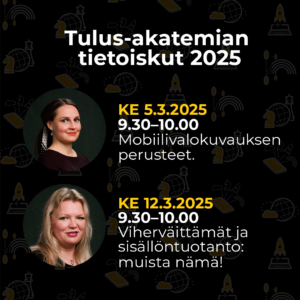Palautteen antaminen ja vastaanottaminen ei ole aina helppoa. Ehkä sinäkin olet joskus saanut palautteen, joka sai palan nousemaan kurkkuun? Tai ehkä olet istunut pöydän toisella puolella? Yritit auttaa kollegaa hiomaan työnsä heikkoja kohtia, ja he ottivat palautteen henkilökohtaisesti ja alkoivat puolustella itseään kuuntelun sijaan?
Ymmärtämällä ja toteuttamalla muutamia perusperiaatteita palaute voi muuttua asiaksi, jota ei tarvitse pelätä. Palautteen saamista voi jopa odottaa innolla. Jatka lukemista, niin saat tietää lisää!
Maailmassa on paljon järjestelmiä ja sääntöjä hyvän palautteen antamiseen. Itse palaan aina yksinkertaiseen kolmen koon perussääntöön:
Ole Konkreettinen, Konstruktiviinen ja Kunnioittava!
On tärkeää muistaa, miksi kommentoit toisen työtä. Ei siksi, että näyttäisit älykkäältä tai nöyryyttäisit kollegaasi. Tarkoitus on parantaa lopputulosta yhdessä.

Konkreettinen
Konkreettisuus eli tarkkuus ja käytännönläheisyys on erittäin tärkeää palautetta annettaessa.
Jos autat esimerkiksi videon tai esityksen kanssa, kerro tarkasti, mistä kohtauksesta tai asiasta puhut. Jos kommentoit tekstiä, osoita täsmälleen, mihin lauseeseen viittaat.
Vaikka on ihan ok kertoa, miten teksti vaikutti sinuun, miltä se tuntui luettaessa ja herättikö se ostohalun, se ei auta kirjoittajaa, jos hän ei ymmärrä tarkalleen, mikä toimi ja miksi. Lopulta luovan tekijän on vaikea hyödyntää tällaista palautetta muutoin kuin taputuksena olkapäälle tai potkuna takapuoleen.
Jos todella haluat parantaa tuotetta, ole konkreettinen, tarkka ja ytimekäs! Osoita täsmälleen, mitkä lauseet toimivat ja mitä voisi parantaa, ja muista kertoa miksi.
Älä sano:
Tuo otsikko on loistava.
Sano:
Käyttämällä sanaa ”sinä” otsikossa tuntuu siltä, että puhut suoraan lukijalle, mikä toimii tässä yhteydessä hyvin.
Konstruktiviinen
Kun olet täsmällisesti osoittanut, mistä osasta tuotetta puhut, on aika olla rakentava. Tällä tarkoitan sitä, että sinun tulisi antaa ehdotuksia siitä, miten työ voisi olla vielä parempaa.
Jos jokin ei toimi, yritä analysoida miksi ja ehdottaa, mikä voisi toimia paremmin. ”Voisitko esitellä henkilön jo tässä vaiheessa, jotta tiedämme, kenestä puhutaan myöhemmin?
Entä jos aloittaisit sen anekdootin koirasta, sen sijaan että säästäisit sen esityksen loppuun? Voisit kerätä kaikki faktat ja luvut laatikkoon, jotta rakenne olisi yksinkertaisempi”, ja niin edelleen. Ymmärrät varmasti idean.
Muista myös korostaa tuotteen positiivisia puolia rakentavalla tavalla: ”Maisemakuvauksesi toimivat hyvin, kiitos aktiivisten verbien käytön. Voisit harkita lisääväsi kuvauksia tänne ja tänne ja tuonne” (ehdota tarkasti, mihin kohtaan kaipaat lisää kuvauksia).
Älä sano:
Tuo otsikko on loistava.
Sano:
Käyttämällä sanaa ”sinä” otsikossa tuntuu siltä, että puhut suoraan lukijalle, mikä toimii tässä yhteydessä hyvin.
Kunnioittava
Ole mukava! Muista, että puhumme toisen ihmisen luomuksista.
Miltä sinusta tuntuisi olla heidän asemassaan? Oman luovan tuotteen esille tuominen voi olla hyvin haavoittuva paikka. Ole siis ymmärtäväinen, ystävällinen ja kunnioittava. Lisää vielä vähän ystävällisyyttä, niin olet valmis!
Älä sano:
Olet surkea, ja niin on työsikin.
Sano:
Kiitos, että näytit työsi minulle ja annoit minun auttaa tekemään siitä vielä paremman.
Bonus K: Käsittele ja hylkää
Ja vielä yksi neuvo sinulle palautteen vastaanottajana: Kuuntele, ota palaute vastaan, käsittele se, ja hylkää ne osat, joita et voi hyödyntää.
Muista, ettei palaute ole henkilökohtaista – mikä tarkoittaa, ettei sinun tarvitse puolustella itseäsi! Loppujen lopuksi tuote on sinun luomuksesi, joten tunnet sen luultavasti parhaiten.
Jos jaatte yhteisen tavoitteen, ja palaute annetaan konkreettisella, rakentavalla ja kunnioittavalla tavalla, palautteen antaminen muuttuu iloiseksi asiaksi.
Onnea palautteen antamiseen – ja vastaanottamiseen!
Jos tarvitset toisen mielipiteen tekstiisi, esitykseesi tai visuaaliseen työhösi, me Tuluksessa olemme valmiina antamaan sinulle konkreettista, rakentavaa ja kunnioittavaa palautetta!




















